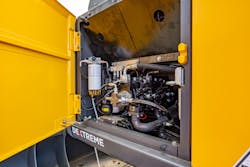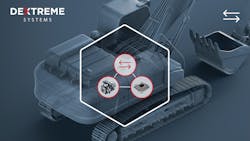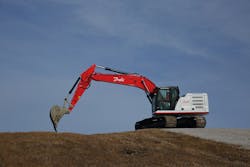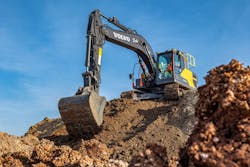Efficiency is becoming an increasingly important aspect for OEMs developing construction equipment and other heavy-duty mobile machines. A more efficient machine – whether diesel- or electric-powered – uses less energy which equates to reduced fuel or battery consumption and thus lower operating costs for machine owners.
Hydraulics and other components can play an important role in improving the efficiency of heavy-duty equipment. Through its Digital Displacement pump (DDP) technology, Danfoss Power Solutions is working to improve the efficiency of heavy mobile equipment, particularly excavators.
Excavators are responsible for about 50% of the global carbon emissions in the construction sector, said Leif Bruhn, head of Digital Displacement at Danfoss Power Solutions, in an interview with Power & Motion. As such, the company has chosen excavators as the first machine type in which it is testing the DDP to help achieve efficiency improvements.
“We are focusing on 90% of the excavators [in the market] which are 10 tons or larger in size,” said Bruhn. “These excavators today are only 30% efficient; 70% [of their energy] is wasted within the hydraulic system, mainly as heat. By focusing on excavators, we're [addressing] one of the largest carbon emitters [in the construction sector]."
Watch our full interview with Leif Bruhn for more on the Danfoss Digital Displacement pump and its uses in construction equipment.
What is a Digital Displacement Pump?
According to Bruhn, the DDP is a truly digitally controlled pump for hydraulic machinery. This is due to the inclusion of an embedded computer which provides a high level of control and faster response times.
The DDP is a radial piston pump equipped with high-speed mechatronic valves which are controlled by the embedded computer. Each of the pump’s outlets has their own control method, enabling flow and pressure from the outlets to be individually controlled.
“We can activate each piston individually, thereby creating flow on demand,” explained Bruhn. “We can realize full- and partial- load efficiency by doing so. Compared to a traditional axial piston pump, [this provides] much faster and more precise control response, thereby optimizing the efficiency of our hydraulic circuit.”
READ MORE: High-Speed Solenoid Valves Control Hydraulic Pump Displacement
Dextreme System for Excavators
The DDP and digital pump controller are the heart of Danfoss’ Dextreme System for excavators, said Bruhn. First shown at bauma 2022 and to the North American market at CONEXPO-CON/AGG & the International Fluid Power Exposition (IFPE) 2023, the Dextreme System is designed to provide up to a 50% energy savings by minimizing losses common with hydraulic systems.
Energy savings are possible with the Dextreme System because of the digital control and fast response times possible with the DDP. According to Danfoss, the fast control response provided by the DDP allows for significant engine downspeeding without stalling the engine. Downspeeding an engine – running it at a lower speed with increased torque to achieve similar performance – has become a common tactic used in the heavy-duty trucking and off-highway equipment industries to reduce fuel consumption. This also helps to reduce emissions and noise levels which improves operator comfort.
The Dextreme System’s digital control allows machine operators to choose how they would like to utilize the system. If reducing cycle times is more important than fuel consumption, operators can use the full rotations-per-minute capability of the engine and achieve up to 25% higher productivity with the system. Performance monitoring and diagnostics are simplified due to the system’s digital control, as well, helping further improve operations for machine owners.
Danfoss has designed the Dextreme System to be power agnostic; it can provide efficiency gains whether the excavator is powered by a diesel engine, or a hybrid- or battery-electric system. In battery-electric powered machines, the system enables OEMs to reduce battery capacity which helps to make the move to electrification more cost effective. Batteries are typically the most expensive part of going electric and reducing the amount of battery required lowers investment costs as well. According to Danfoss, the Dextreme system can also help increase the run time of electrified machines without using a larger battery, further helping to reduce costs.
READ MORE: The Current State of Battery Technology
At IFPE 2023, Danfoss launched its Dextreme systems pathway which consists of three incremental system solutions called Swap, Flex and Max. Dextreme Swap is the first commercially available version and the simplest configuration of the three. It replaces an excavator’s main hydraulic pump with a DDP, custom software and a digital controller. With this version of the system, a 15% reduction in fuel use and carbon dioxide emissions compared to an excavator fitted with a conventional swash plate pump.
The Dextreme Flex and Dextreme Max versions build upon the Swap system to provide further efficiency gains. Dextreme Flex is expected to provide 30% energy savings by dynamically allocating pump flow based on demand. This reduces throttling losses in the main control valve which could otherwise impede the efficiency of a hydraulics system, and thus the excavator.
Dextreme Max is predicted to provide as much as 50% energy savings through the addition of energy recovery capabilities. It will do so by recovering what would otherwise be wasted energy during machine movements such as slew deceleration and boom down. Direct load control from the DDP will also offer further reductions in throttling losses.
Proving the Potential for Efficiency Gains
Since acquiring the DDP technology from Artemis Intelligent Power in 2018, Danfoss has not only advanced its design but also continued to research the capabilities of the digital pump.
In 2022, the company published new research into the pump’s ability to reduce battery requirements in excavators. By pairing a DDP with an electric motor, the amount of energy required to operate an excavator is reduced which enables a smaller size battery to be used.
Danfoss worked together with the Advanced Propulsion Centre UK – which partners with government and industry to accelerate industrialization of zero-emissions technologies – on the research, which was presented at the International Fluid Power Conference in June 2022. The Advanced Propulsion Centre developed a simulation model of a 16-ton tracked excavator and determined its energy requirements for a typical 8-hour shift. An electric machine equipped with a traditional swash plate hydraulic pump was compared to an excavator fitted with the DDP and electric motor.
It was determined the DDP and electric motor version required up to 24.8% less energy, depending on the system complexity and duty cycle of the excavator. This means a 314 kWh capacity battery could be used instead of the 418 kWh battery utilized in the excavator with a swash plate hydraulic pump. Batteries are not only expensive but also add weight to a machine; having the ability to use a smaller size battery helps to overcome both of these challenges currently plaguing electrification of off-highway equipment.
Danfoss is also currently testing its Dextreme System in partnership with Ashcourt Group, a building materials supplier based in East Yorkshire, England. As part of the testing, three Volvo excavators have been equipped with the Dextreme Swap system.
The machines are 20-ton diesel-powered Volvo EC200 excavators. Ashcourt plans to complete 2,000 operating hours with each machine over the next 12 months; two will be used at its quarry and the third at the company’s material washing facility. Data logging equipment has been placed on the machines to compare the Danfoss equipped machines to Ashcourt’s existing fleet of standard EC200 excavators.
“Our goal is to see how the Danfoss Dextreme-equipped machines perform in terms of productivity and fuel use in a tough quarrying and material moving environment,” said John Hood, Ashcourt Group plant director, in Danfoss’ press release announcing the project. “So far, the feedback from our operators has been uniformly positive. The fuel savings I can’t speak to yet, but my team is telling me the new machines are very responsive and strong, with the EC200 performing more like an EC250.”
Through research projects like these, the Danfoss technology can be used in real-world applications to demonstrate and prove its capabilities. According to Bruhn, one of the biggest challenges is the industry “knowing this technology is out, it’s ready and can be applied.”
Medium- to large-sized excavators, which comprise the largest volume of those used in the construction industry, are the key target area currently for the DDP and Dextreme System. But the company sees applicability in other machine types and applications as well.
“We’re focused [on decarbonizing the construction industry] together with our customers,” said Bruhn in the interview with Power & Motion.
“We've been working on this technology for quite a while, and we have been working with great partners along the way. That work needs to continue and expand…and [we need to] tackle the challenges of adopting this technology together [with customers] and bringing it to market fast with our Dextreme System solution approach,” he concluded.






